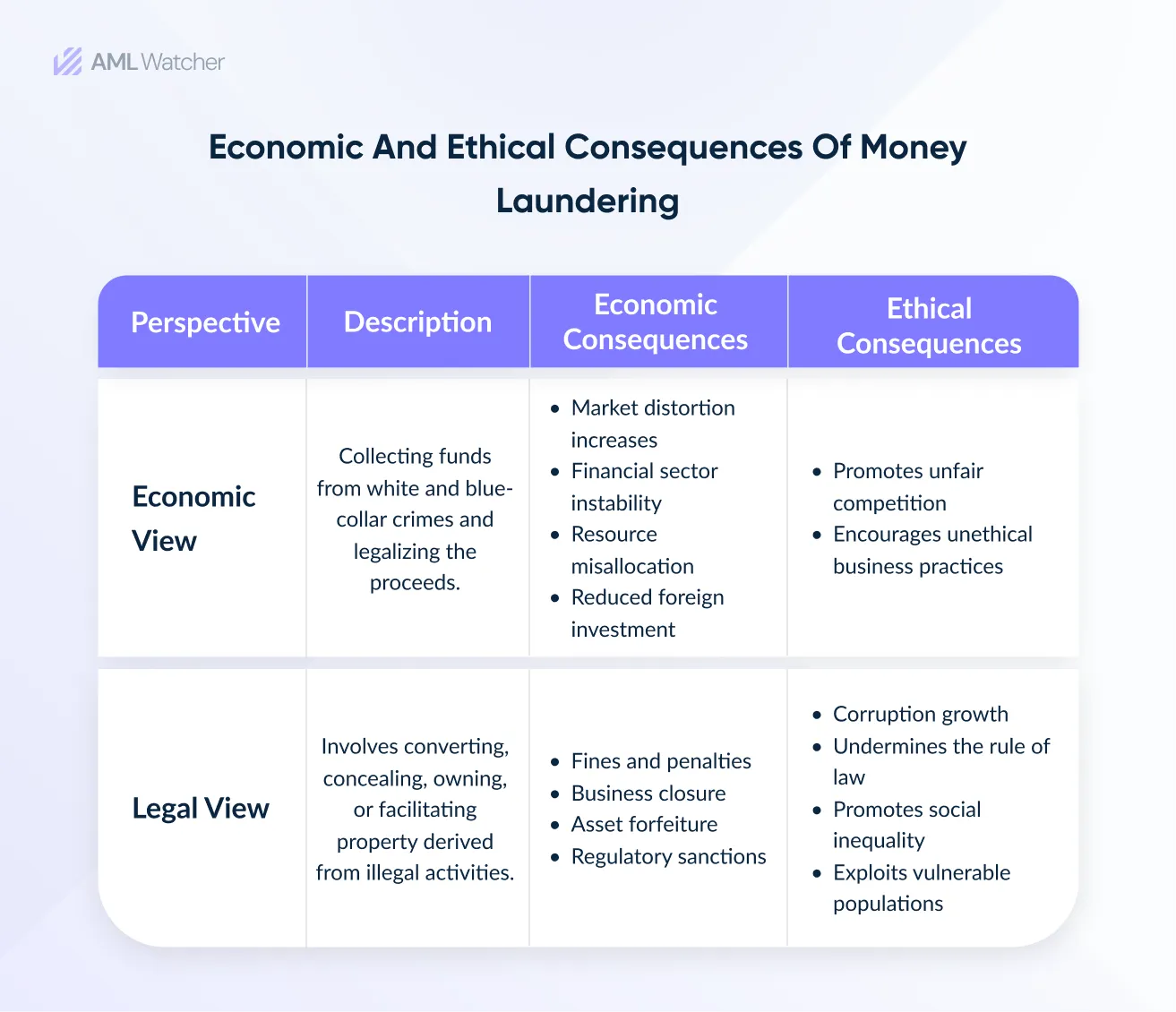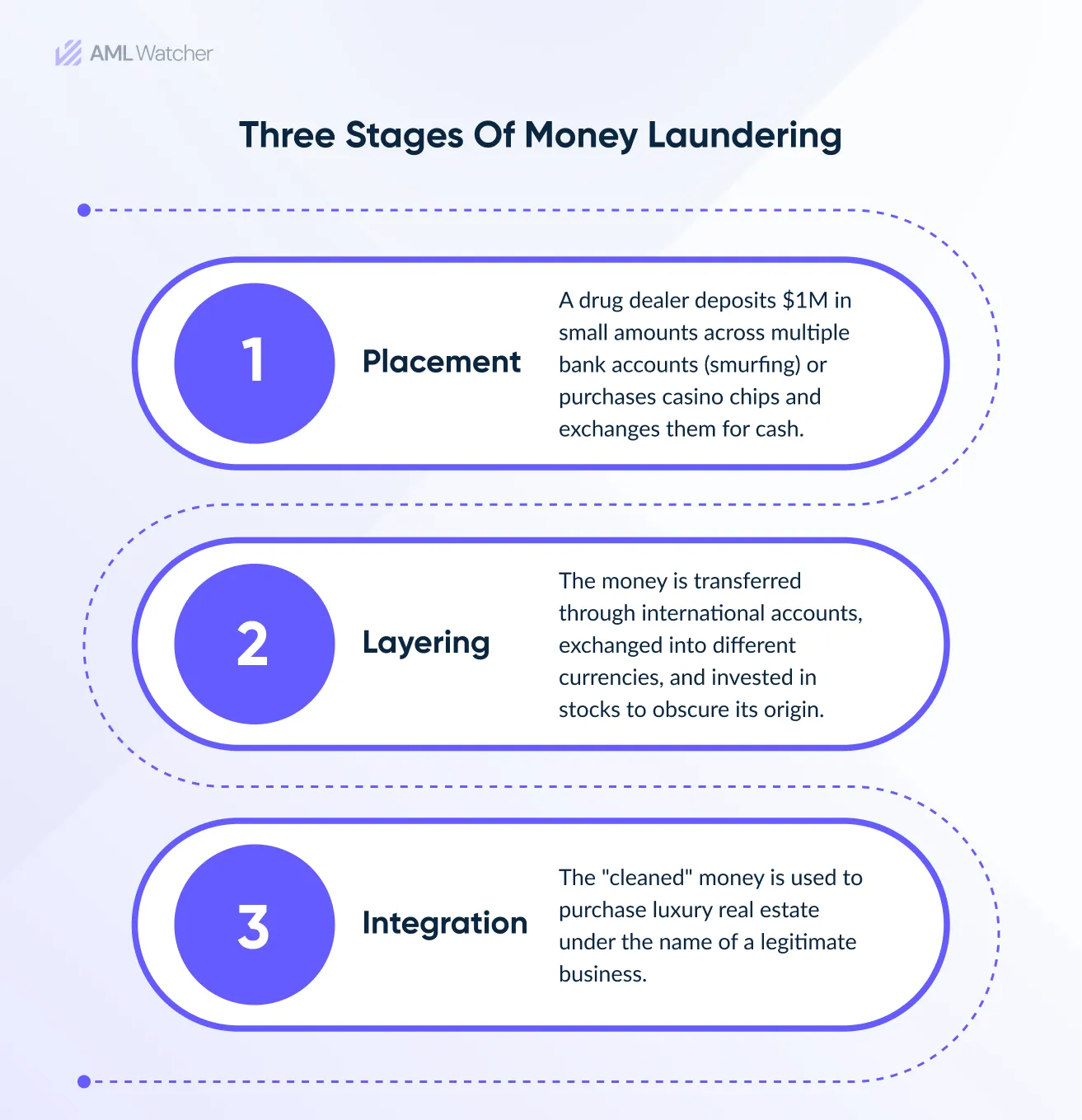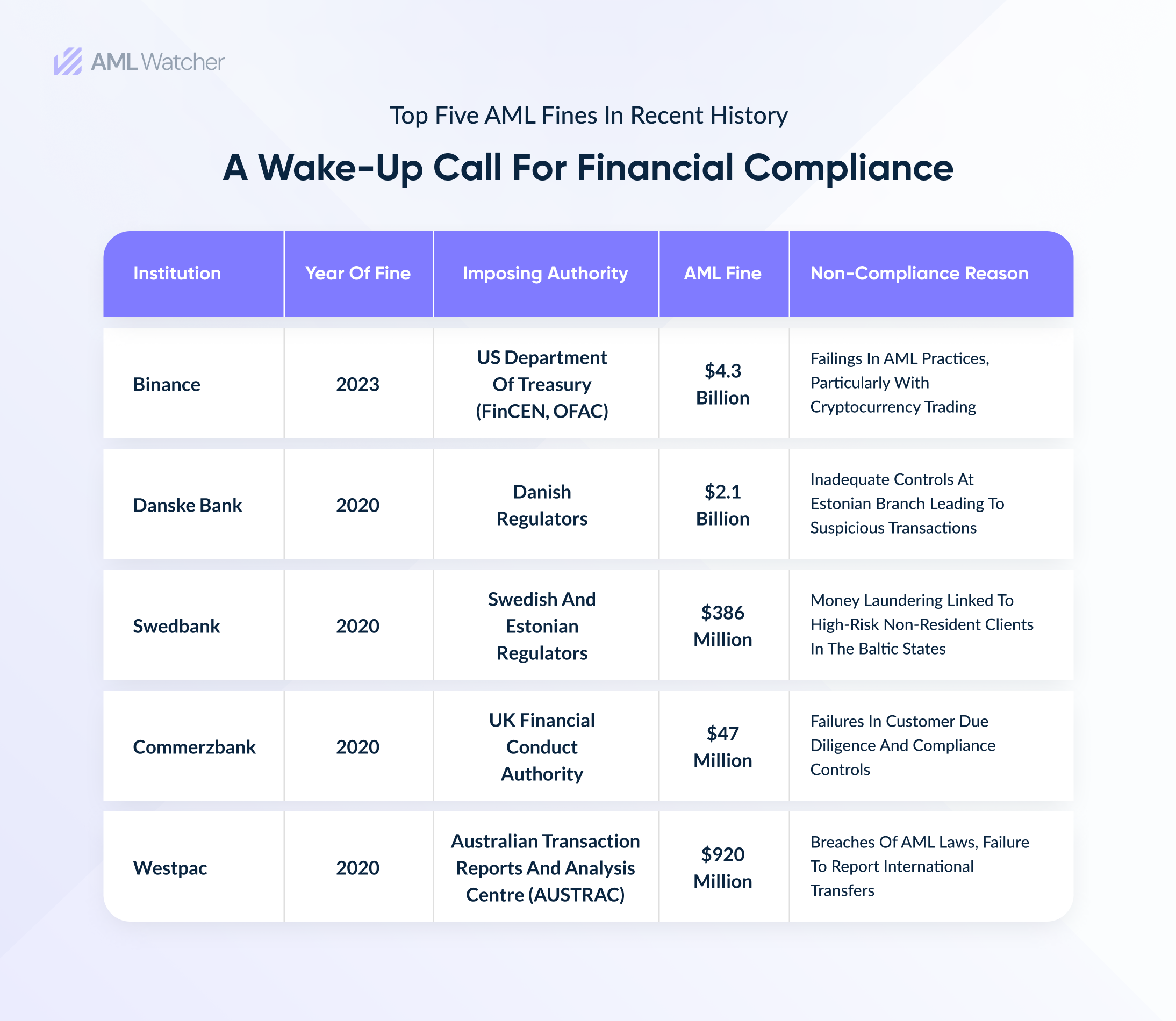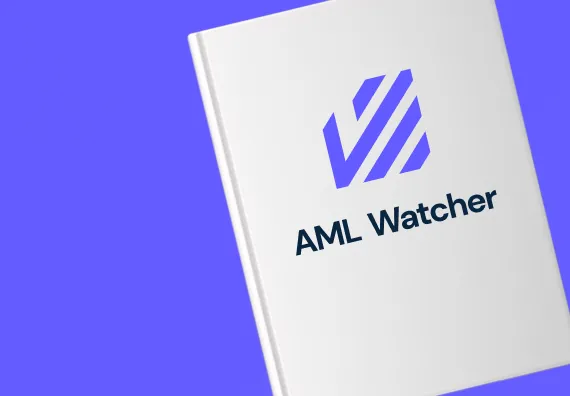
Things You Need To Know About 3 Stages of Money Laundering
Money laundering is not just a financial crime; it is a multistep organized crime used by criminals to mask the origin of illicit funds. Trillions of dollars were laundered yearly by showing dirty money as legitimate.
A 2024 United Nations Office on Drugs and Crime report states that 2 to 5 % of global GDP comes from yearly laundered money. Which is approximately between $2.22 trillion and $5.54 trillion.”
Laundered money fuels illicit activities such as terrorist funding and corruption. Financial institutions and other businesses must comply with AML regulations to prevent money laundering.
Understanding the money laundering stages will allow you to identify suspicious activities and ensure compliance with AML regulations and laws. It has been divided into 3 stages of money laundering, e.g, “placement, layering, and integration.”
Each step is designed to make its tracking difficult. In the blog, we will critically analyze and understand the complexities of each money laundering lifecycle.
What comes to your mind when you hear the words Money Laundering? It’s just like cleaning black money (illegally obtained funds) by making it legitimate, just like washing dirty clothes in a washing machine so they can be reused.
Before digging into the details of the infamous phenomena of money laundering stages, let’s take a sneak peek at the human perception and history of the said activity.
A Brief Recap of Money Laundering History
History tells us that the term laundering was established when an infamous gangster, Al Capone, laundered his illicit proceeds through his laundry business. It also states the origin of laundering money from the Watergate scandal, dating back to 1973.
The infamous Watergate scandal, which exhibits the political crisis and abuse of power, was facilitated through money laundering. Different criminal tactics were used to exploit the national economy and the stability of financial systems.
The Three Stages of Money Laundering
Below are the stages of the money laundering cycle that need to be identified to effectively detect financial crimes that deteriorate the stability of global economic systems.
Placement
According to William Rosenblatt, the first stage of money laundering is placement. The goal is to introduce dirty money into the financial system without raising doubts about suspicious activities.
Introducing illicit money into the system is the first step of a dirty game played by criminals. Large amounts are obtained illegally by criminals, who introduce them into the legitimate financial world.
The origin of Money collected from illegal activities such as human or drug trafficking, should be masked to make dirty money appear legitimate.
In this case, financial criminals often transfer their money to the mafia or money mules, who deposit smaller amounts (smurfing) into various accounts to avoid detection of the source of funds.
Layering
The money placed then goes through a complex layering process to hide the origin of funds, which is called layering. It can be done through international transactions or intricate, complex transfers.
In the layering process, money mules play the main character role, or depending on the extent of laundering, the job is performed by highly trained and organized professionals. With their expertise in legal, accounts, and compliance departments, compliance watchdogs find it challenging to identify shady transactions.
The difference between ways of placement and layering is the purpose. However, almost the same methods are used in both stages.
Money laundering as a service makes it the most shady job, which is then empowered by regulatory gaps in some jurisdictions. According to CIFAS, anti-crime agencies identified over 40,000 accounts of money mules used for systematic money laundering. Ironically, out of them, 50% were under 26 years old or younger and were hired through social media channels.
It does not stop here as the transferred money reaches different destinations: shell companies or foreign accounts with ambiguous beneficial ownership. Weak regulatory reforms in some countries make launderers’ jobs easy with minimum to no due diligence or verification processes in place.
The legitimacy of shell companies is made possible through fake contracts and organized documentation to satisfy FATF compliance mandates.
Money transfers between two companies in different countries and money can be laundered in the form of goods or existing on paper in Trade-Based Money Laundering (TBML).
Integration
Once the layering is done, the dirty money is ready to enter legitimate financial systems through integration. It is done through investments in real estate, purchasing expensive goods, or more complex schemes such as loan-back schemes.
The money, through layering systems, is spent in less regulated and cash-intensive sectors, including arts and entertainment, tourism, and construction industries.
A similar framework of integrating illicit funds into the legal economy exists in different regions of the world. Hawala Hundi is notorious for money laundering purposes in the Indian Subcontinent while flying money known as Fei Chien in China.
Irrespective that substandard due diligence and regulatory gaps facilitate money laundering activities and associated financial crimes, it is essential to understand that many efforts are being made to stop this epidemic from spreading. Increased regulatory reforms in countries such as the U.S., Europe, the U.K., and other developed countries motivate institutions to maintain AML compliance within their systems. The 3 stages of money laundering help to understand the complexity of money laundering and how criminals mask the dirty money to look legitimate.
Unforgiving Regulatory Reforms Against Money Laundering
A collective effort to stem criminal activities and facilitate acts of money laundering was initiated when drug and human trafficking overtook the streets of the United States and Europe. UNODC (United Nations Office on Drugs and Crimes) estimated that around $800 billion of generated money is laundered each year, which presents the only detected stats while millions of dollars go undetected.
The modern world has seen and heard a lot about rigorous enforcement actions by governing bodies, establishing a known term of Anti-Money Laundering (AML) measures. These global AML laws are made to implement strict screening and verification protocols to detect and prevent 3 stages of money laundering and associated predicate crimes.
The establishment of the global regulatory body FATF (Financial Action Task Force) in 1989 and the BSA (Bank Secrecy Act) 1970 in the United States prove that money laundering and the later added mandate of financing terrorism should not be tolerated at any level and cost.
The endorsement of BSA/AML measures can be better understood by the increasing enforcement fines that institutions, particularly financial institutions, have paid so far. Monetary costs aside, violations of AML laws have caused institutions legal and reputational burdens.
Highlighted below are some major cases that show how rigorously enforcement actions can be when institutions fail to detect money laundering and indifferently facilitate the corrupt actors.
Let’s take a look at sectors that are prone to money laundering.
4 Major Sectors Prone to Money Laundering Stages
There are several ways that money launderers use to hide or legalize their illicit proceeds. Money laundering stages allow us to understand the detailed method.
A research was published in the Crime, Law, and Social Change journal, which states some general ways to hide their assets and never be linked to those assets if identified. Below are general statements highlighting conventional behaviors while implementing steps to launder money.
- They avoid the most regulated industries, such as banks, and exploit areas with minimum to zero AML regulations, including real estate and antiquities markets.
- Money launderers choose middlemen, generally known as strawmen, to launder their illicit gains to hide the real beneficiary of assets. An artist with an art degree and background and a professional with an accounts background can be selected to launder money in antiquities and consultant firms, respectively.
- The corrupt actors target those jurisdictions with less active responses to money laundering activities to plot their schemes. Cross-border weak cooperations facilitate laundered in hiding and laundering their black money.
- The blend of clean and dirty money is another suitable way to confuse law enforcement agencies in identifying the money linked with laundering.
- Money launderers utilize the expertise of professionals with access to financial and compliance systems, which facilitates executing their shady schemes by constructing undetectable routes within the system.
Money Laundering Through Banks
Increased AML scrutiny in banking systems does not stop money laundering activities, as the primary compliance of banks is to identify the beneficial owners of accounts. Hiding the beneficiary using strawmen where the original launderers do not have to deal with banks.
Moreover, banks with targets to meet sales prefer to trust their clients and often overlook due diligence. On top of that, the complex structures of shell companies and offshore accounts make it difficult to identify laundering activities.
The interviews conducted in the research study showed that financial institutions, mainly banks, are suitable for money laundering.
Money Laundering Through Consulting Firms
Money launderers ideally exploit the global and flexible nature of consulting firms.
These consulting firms are usually portrayed as offering legitimate services to local clients, which can be verified, while providing ambiguous services to regions with less transparent compliance systems.
The operations of such firms are run by strawmen where real beneficiaries never come out front, making it easy for launderers to exploit regulatory gaps.
Money Laundering Through Antiquities
The undetectable prices of antiquities materials make them ideal for money laundering purposes. The prices of such materials depend on the buyer’s preference or interest in the art pieces, which makes it difficult to estimate the actual cost of a material.
Such pieces generally require one-time asset verification and are sold many times in different jurisdictions to bypass compliance checks. The other most likely opportunity abused by money launderers is setting up an antique shop in remote areas where legitimate business activities happen to cover up the suspicious transactions.
Money Laundering Through Real Estate
The most suitable sector for money launderers, real estate, is exploited by corrupt actors regarding hefty cash transactions and manipulation of property valuations. Buying a real estate property and renovating it in partial cash payments can benefit both parties in evading taxes.
These renovated buildings are rented out for extended periods while the illegal proceeds are mixed with rental income and black money turned clean. In the final stages, the property is sold at elevated prices, calling it a hike in market prices, and eventually, the laundered money enters legitimate financial systems.
Below is the quantitive analysis of the above-discussed sectors with a likelihood of money laundering, supported by the research study.
Let’s take a look at sectors that are prone to money laundering.
How Anti-Money Laundering Compliance Can Be Achieved?
It is inevitable for institutions to follow the regulatory guidelines and help law enforcement agencies in fighting against money laundering. Financial organizations and businesses that take steps to counter money laundering are referred to as AML stages, such as “Customer Due Diligence (CDD), Transaction Monitoring, suspicious activity reporting (SAR), and Compliance and Auditing.”
Compliance Culture & Awareness
AML compliance measures are easy to implement once they are understood well. To create a credible and accountable compliance culture in the system, institutions need to provide staff with an awareness of the importance of these measures.
The long-term impacts of non-compliance can be one of the motivations, but protecting the global economic platform from these corrupt actors is essential.
Know Your Customer & AML Checks
Following the globally recognized regulatory mandates, businesses must conduct appropriate verification and screening processes for their new and existing customers.
KYC (Know Your Customer) and AML screening are integrated into compliance programs to facilitate these verifications.
How AML Watcher Can Help You?
AML Watcher helps reduce the risks of money laundering by providing comprehensive screening across global sanctions, PEP lists, Watchlists, and adverse media. Its advanced algorithms detect suspicious activity, flagging potential risks in real time. AML Watcher ensures accurate identification and reduces false positives, improving overall compliance efficiency by leveraging proprietary data and contextual analysis.
Reach out to meet your customized compliance needs and stay ahead of the regulatory curves.
Frequently Asked Questions
Three stages of money laundering are:
Placement: Introducing the illegal money obtained by illicit activities into the financial system.
Layering: Moving the dirty money and hiding its origin through complex transactions and other methods makes identifying the origin of funds difficult.
Integration: Successfully blends dirty money with legitimate funds and funnels clean cash into their account for further use in illicit activities such as terrorist financing.
The common techniques used in money laundering are mentioned below:
- Smurfing: Breaking larger amounts of money into smaller deposits to avoid detection of the source of funds.
- Shell Companies: Using Fake Business to hide the true origin of funds.
- Real estate: buying and selling property to legitimize the illegal money obtained by illicit activities,
- Trade-based laundering: Over- or under-invoicing goods to move money and hide its source.
- Cryptocurrency: Using digital assets to move funds quickly and hide the source of funds.
The 4 stages of money laundering are:
- Placement: Introducing illicit funds into the financial system, such as depositing cash into a bank account.
- Layering: Masking the actual ownership of funds through complicated, organized transactions such as transferring the funds between multiple accounts
- Integration: Mixing the dirty money with clean money to make it legitimate funds such as investing in business and then use it for further purposes like funding terrorism
- Concealment: Additional steps are used to hide the origin of the money further to prevent the detection of funds, such as offshore accounts.
It is commonly referred to as layering and is the second step in the money laundering process. In the layering technique, funds are repeatedly moved across different banks, accounts, or products, in order to make it difficult to trace back their origin to their illegal sources.
Some of the factors that make the placement stage of money laundering most likely to be detected include:
- Structuring patterns
- Large cash deposits
- Unusual transactions
- Transactions that lack economic or legal purpose
- Purchase of high-value goods with cash (real estate, vehicles, or luxury items)
Laundromats, strip clubs, and casinos are considered ideal for the placement phase of money laundering due to the fact that most of their revenue comes from cash sales. Cash sales are generally not recorded, as no accounts receivable are involved and represented merely by an increase in any revenue. These properties make it ideal for such businesses to artificially inflate sales and manipulate invoices by mixing cash from other illegal sources.
We are here to consult you
Switch to AML Watcher today and reduce your current AML cost by 50% - no questions asked.
- Find right product and pricing for your business
- Get your current solution provider audit & minimise your changeover risk
- Gain expert insights with quick response time to your queries






